Paranoid Mania and Ecstatic Joy: How David Byrne arrived at ‘American Utopia’
Hope comes to town
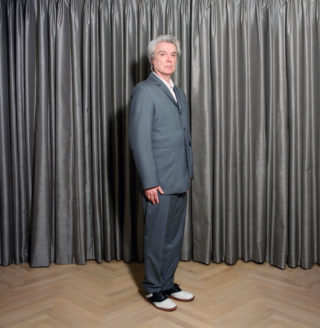
Hope comes to town
“What’s heaven like for a chicken?” ponders David Byrne with curious, darting eyes, before rocketing his head back and breaking out into manic laughter, exposing a set of pearly white teeth to match the creamy London hotel suite he sits in.
It’s a question Byrne poses on his new record, ‘American Utopia’, on a song called ‘Every Day is a Miracle’. The responding lyric goes: “Full of roosters and plenty of corn / And God is a very old rooster / And eggs are like Jesus, his son.” It’s a song loaded with other similarly incongruous proclamations, such as, “The Pope don’t mean shit to a dog / And elephants don’t read newspapers,” and it explores what it must be like to be, “a cockroach in the cosmos of your heart,” before clearing up any confusing matters by declaring, “the mind is a soft-boiled potato.”
“There’s quite a few songs that have to do with imagining how the world looks from the point of view of another creature,” Byrne clarifies. “I think the implication is to try and look at things from the point of view of other people, but I pick creatures because it’s sometimes more fun. Then you just go on from there and then you realise that our own conception of these things must be just as limited as theirs. We fancy that we’re a lot smarter than chickens, and I hope we are, but…” he stops himself and begins laughing again, something that will punctuate the entire conversation. “In some odds we must be just as limited and I think there’s something in that in the record.”
The ex-Talking Heads frontman is an immediately fascinating and striking man. His bright white hair wrestles it out with film director Jim Jarmusch for best hairdo for a mid-60s New Yorker; he wears a grey suit and crisp white shirt with black-rimmed glasses tucked between the buttons, and he sports two-tone golf shoes but with the spikes removed. “They are comfy,” he says when asked about them when walking through the hotel lobby and into a lift. “I suppose they are good shoes for men who like to stand all day, that’s what golf is really isn’t it? Standing.”
Byrne comes loaded with nervousness and gives off a sense of slight discomfort. His eyes are a constant back and forth and up and down, rarely making eye contact for longer than a few seconds. He wriggles in his seat back and forth, legs crossed and then uncrossed, hands on the table and then on his lap and back again or clinging to his icy glass of water. He is at once loquacious and phlegmatic, loose and rigid, stumbling and flowing. There’s an undercurrent of panic from time-to-time, like he’s sitting in a job interview (which ostensibly he is) but this is broken up by bursts of laughter to ease any slight awkwardness. Byrne is idiosyncratic but he’s good company and very funny. He gobbles up laughter with the same voracious appetite as he reportedly does his food and if you laugh at something he’s said, it’s like a thumbs up for him to sink even deeper into his own. The title of a track by The Feelies (a group unquestionably influenced by Talking Heads) immediately springs to mind when conversing with Byrne: ‘The Boy With the Perpetual Nervousness’.
Such anxiety and nerves has been key to Byrne’s career, though. The nervy, jittery, sparse and scattered sounds of Talking Heads’ early period is a manifestation of such self-proclaimed oddness. “I used to be very tense and nervous, I couldn’t relax,” he told Jools Holland back in 1994 when asked about this on his show. Holland – a remarkably, and consistently, inept and inattentive interviewer – misses the humour and the ‘Psycho Killer’ lyric-quoting response. Byrne continues: “I knew I had to take that step up and be that nervous person behind the microphone. You get it out in the songs and then you don’t have to kill anyone in real life.” Once again Holland misses the sandpaper-dry, ink-black response and continues to ask an utterly inane question about Byrne’s hands as the humour flies over his head with the force and speed of a thousand fighter jets. No wonder Byrne occasionally comes across as strange or uncomfortable on TV.
Today, he is far from the man as seen on other television appearances, such as The David Letterman Show in 1983, when he looked as though he was praying for an ejector seat to fire him out of the studio with every new question asked. Nor is he the man on American Bandstand with Dick Clark in 1979, when he froze up on air to such a degree that Clark had to turn the microphone to bassist Tina Weymouth and ask, “is he always this enthusiastic?” to which she replied, “I guess he’s organically shy.” Weymouth is correct, Byrne is shy, no question about it. But lacking enthusiasm? Resolutely, no. Byrne is bursting with it.
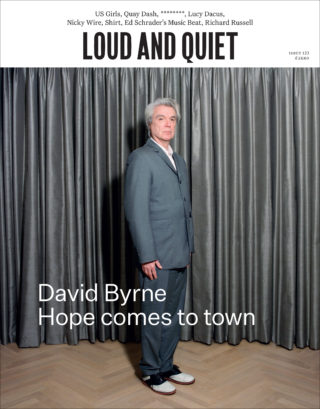
Not only is such enthusiasm documented through his fecund career – one that includes eight Talking Heads albums, numerous solo and collaborative records, books, films, soundtracks, installations, exhibitions, a record label, a radio show, musicals and more – but also in his manner when speaking of his work. Aside from releasing a new record, Byrne has been touring the world with a lecture entitled Reasons to be Cheerful: a scattered look at some of the good being done and progress being made all over the planet in a time of what can often feel like unrelenting misery. “I thought these talks would give the promo schedule a little more variety and something else to talk about besides my record,” he laughs. “It’s looking at good innovation, renewable energy, positive drug policy… a lot of different stuff.” This was born from a period of sourness that Byrne was feeling. “I was feeling pretty miserable,” he says, “and still do a lot of the time. I’m not a miserable person most of the time but I wake up and read the paper and feel angry, depressed and cynical. I thought that’s not very healthy for myself and it’s not very productive, so I thought what can I do?
“The title references an Ian Dury song. It was written during the Thatcher era, so there was probably a similar feeling. It was a period in which people were writing a lot of angry songs and he came out with ‘Reasons to be Cheerful’, which seemed a little perverse at the time. But I thought that was a good thing to do.”
This ties into the un-ironic title of his latest album, ‘American Utopia’. It’s Byrne’s first solo album in 14 years but it didn’t start out as one. “At first I thought it was going to be another David Byrne and Brian Eno record.” he says. Eno features briefly on the album, as do a range of guests including Oneohtrix Point Never’s Daniel Lopatin, Sampha and Jam City. “It started off with me writing over some drum tracks he [Eno] had. They weren’t fleshed out with all the instrumental bits but they sounded really interesting. I got excited and worked over those and then added some other musicians. I kept playing them for Brian and he would add more but then eventually he said, ‘I think this is your record now,’ and I said, ‘yeah it does seem that way’. It wasn’t my intention to run away with it but that’s what happened.”
Byrne’s collaborations with Eno span decades. They last worked together on 2008’s ‘Everything That Happens Will Happen Today’ but they met in 1977 when John Cale took Eno to see Talking Heads support the Ramones. Byrne found himself back at Eno’s having his mind ripped open by the sounds of Fela Kuti and they further bonded over their shared fascination with scientific approaches such as cybernetics. Eno would go on to produce three seminal Talking Heads records (‘More Songs About Buildings and Food’, ‘Fear of Music’ and ‘Remain in Light’) as well as collaborate with Byrne on 1981’s masterful ‘My Life in The Bush of Ghosts’. Byrne credits their ongoing relationship to eclectic interests. “Sometimes we’ll have conversations and not talk about music at all. I think that has kept our friendship going, but also distance,” he says, referring to them living in different countries.
Presumably Byrne and Eno continue to creatively spark because of a matched desire to move forward, avoiding the past and not repeating themselves? “Yeah,” Byrne says. “Although I realise I am going to repeat myself in some ways, whether there’s certain themes or points of view I return to unwittingly, but musically I try to avoid it as much as I can. It’ll happen but I’m not trying to recapture something; some glory days from the past. I’m not very nostalgic.” As for what makes for a fruitful collaboration in the eyes of Byrne, he says: “I think sometimes the ones that are the most successful are…” once again his stops himself to chuckle and show off those teeth. “It’s like… good fences make good neighbours. When you know where the boundaries are and you set those rules in early, it makes it go very smoothly. Creative boundaries, I mean, not like ‘get out of the room! get out of the room!’”
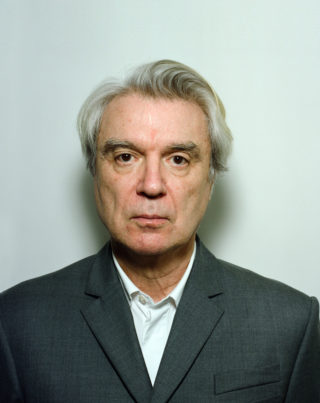
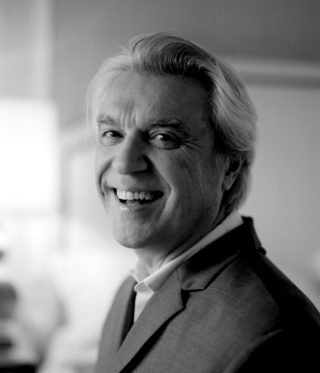
Byrne’s latest album, and arguably his career, is defined by an earnestness coated in oddness. Making the ordinary extraordinary. The inanimate emotional. A sort of abstract sincerity. Coming across too directly or as preachy was a concern to Byrne when doing such an album as ‘American Utopia’ complete with the lectures. “I’m very wary of that,” he says. “I’m wary of doing anything where it seems like I’ve got answers or that I’m telling people what they should be doing. More often I ask questions, or in the Reasons to be Cheerful thing I’m pointing out things that other people have done that can be encouraging, rather than saying, ‘you should do this.’ As I was wrapping up the record, it felt like it seemed to pose these questions or make observations about who we are and what am I, what are we about, what do we want, all these kinds of things and…” he pauses before the laughter kicks in again. “It doesn’t answer any of them.”
Byrne has long been an observer over a concluder, plucking thought, insight and intrigue from seemingly nowhere, like a scientist moving from experiment to experiment. A keen cyclist, he sucks in cities, places and people as he moves through them like a rolling sponge. In 2012, he spent days listening to and recording the sounds of London to such a degree that he worked out the city beats at exactly 122.86 beats per minute.
And much like Byrne glides through the world, absorbing and observing, his new album drifts through genres, characters, points of view, moods, tones and grooves. In an emblematic fashion of his whole output, it feels like the presentation of a painter’s palette as much as it does a finished painting. St Vincent’s Annie Clark spoke of Byrne’s ability in this department when they collaborated together in 2012 on ‘Love This Giant’. “David is capable of so many shades and moods and one of them is a rare combination of paranoid mania and ecstatic joy,” she said. “It’s a really unmistakable, singular tone. He also has an ability, lyrically and musically, to talk about or address big subjects in a way that never feels pretentious or lofty.”
Such big subjects that Byrne manages to address with this blend of paranoid mania and ecstatic joy are rooted in the current political climate. This is a clear impetus for his exploration of an American Utopia and to seek reasons to be cheerful. In a 2016 journal entry on his website, he wrote: “I am saddened by the low level to which U.S. politics has sunk. The hate, vindictiveness, personal insults, racism, and pandering – it seems that the worst aspects of the Internet have come to life and turned into flesh and blood.” So, is ‘American Utopia’ a political record by Byrne’s own definitions? “In a certain way but I’m certainly not singing about any specific issues,” he says. Byrne is subtler than that and instead he plunges into areas of abstraction and absurdity to explore such themes. Humour is a big tool for him too. “It’s an antidote for me and it also can disarm people. Sometimes you can get people to entertain an idea or something they might not normally accept or deal with or think about if there’s a little bit of humour involved.”
Skating around political discussions it’s clear that there’s one man at the centre of a lot of this upheaval, yet the giant breathing fatberg that is President Trump is yet to be mentioned directly. So what does David Byrne think of his president? He starts, of course, by manically laughing. “Erm… wow… erm… I feel like him getting elected is a symptom of something else. I feel like it goes quite far back. I’m old enough to have felt that, for me, there was a shift in the ’80s and there was an acceptance of a more cynical attitude, a more money-grabbing attitude. I feel like that never really went away – the Reaganomics of trickle down theory and all that kind of thing. That was really cynical and was proved completely wrong but that has never really gone away and it keeps going. Then you add in other factors like people living in their bubbles and getting their news from Facebook and the vast inequality and all these other things and you have a perfect storm. Then the country elects a reality show meathead, and you go alllll…right.” He recently went as far to say, “he’s a fucking racist.” to Rolling Stone.
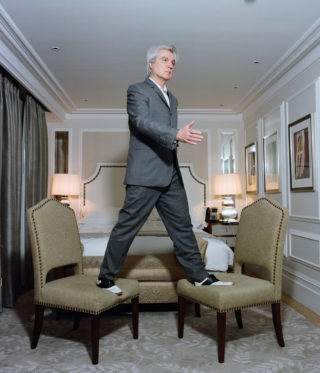
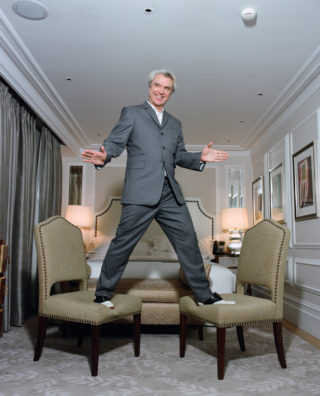
The role of music as a healing process is something Byrne has long explored and discussed. He’s previously mentioned he felt that he was “mildly autistic” and probably with “an undiagnosed case of Asperger’s Syndrome” in previous years but he feels music brought out his confidence and that he “grew out of it.” Byrne feels like in many ways he’s gradually been unlocking more of himself and his own abilities as the years and projects have gone on. “Yeah, it’s taken time,” he says. “Sometimes I imagine if I had died early on that I wouldn’t have been done yet, I’d only be half finished.” he says, leaving it open to interpretation if he’s referring to his creative output or his own personality construction.
Despite this ever-growing confidence with every new project that he embraces, he still worries about the impact and results of his work. “Yeah, I still have a fear of failure,” he says. “But I also don’t have a huge fear of taking risks and trying things out. I’m willing to try things but I think one of the reasons I am is because there’s nobody with a gun to my head. If I’m not happy with it I can just say, ‘fine’. I’ll fail on my own terms and I’ll be the one to blame.”
I ask if the fear of failure is rooted in letting himself down or his audience?
“I think it’s myself,” he says after a brief pause and jittering around in his seat some more. “I have a certain amount of pride and ambition in my work. Of course I’d like it to be heard and enjoyed by as large a number of people as possible but I can also be just as happy if it’s a smaller audience that likes it – that wouldn’t be deemed a failure.” In 2009, he told the Telegraph that, “I never get stuck or run out of ideas but I don’t always hit the peaks.”
His voice sounds glorious on this record – pristine, confident and glowing. This is an area that, over the years, has unearthed new parts of him and subsequently altered the tone of his music. “I realised some years ago that I enjoyed singing. I think in the early days it was an act of desperation, I needed to get things out and then at some point it became pleasurable. The very act of it became enjoyable. Which worried me a little bit. It was great because it made me feel good but on the other hand I thought maybe all the edge that comes from that desperation is going to be lost. That maybe I’ll sound too happy. The singing may have improved but I think the oddness is still there.” The same goes for Byrne’s relationship to dancing. “I didn’t used to do a lot of dancing,” he says. “I did more twitching than dancing early on but now – even though it’s still not really conventional – there’s more pleasure in it.”
Of course dancing is a central image burned into the minds of many when they think of David Byrne. In particular, his astonishingly unique moves as captured in Jonathan Demme’s 1984 masterpiece, the live concert film of Talking Heads, Stop Making Sense. Bryne’s moves are swan-like, both in a sense of like a swan landing and gliding on water – the presentation graceful and fluid – and also the spectacle that you’d see if you peeked below the surface of the water to see kicking and twitching legs moving chaotically – a blend of discordant harmony. ‘Stop Making Sense’ comes into conversation as Byrne has described his plans for this tour as, “the most ambitious since ‘Stop Making Sense’”. This will consist of a completely empty stage, all players mobile and on wireless mics and amps, no risers, drums but no drum kit. “Completely clutter-free, it’s all about us moving around,” he says.
Asked if he loves ‘Stop Making Sense’ as much as the whole world seemingly does, he replies with a simple, “Yes, I do,” before going on to talk about the simplicity of the idea and the pragmatics of the set-up of the show, something Byrne became fixated with. In the wake of Demme’s death last year, he elaborated more on the beauty and uniqueness of the performance itself and what Demme plucked from it. “Jonathan’s skill was to see the show almost as a theatrical ensemble piece, in which the characters and their quirks would be introduced to the audience and you’d get to know the band as people, each with their distinct personalities. They became your friends, in a sense. I was too focused on the music, the staging and the lighting to see how important his focus on character was – it made the movie something different and special.”
Byrne’s particular, difficult and occasionally demanding side came out during the making of that production. He became so obsessed with the details and the aesthetic presentation of the set that he wouldn’t even allow a bottle of water on the stage because they could reflect light and appear out of place with the all-black set. Similarly, any brandings on the guitar amps were also covered over in a matte black paint to avoid light and to make sure they didn’t catch a distracted audience eye. He even confessed, with much shame, to throwing microphones in the direction of the crew during the production, as a result of obsessions turning into tantrums.
He understands that his idiosyncrasies have occasionally had negative repercussions but he tells me it’s something he’s comfortable with. “Yeah, I accept it and I embrace it,” he says. “I have moments when, like all of us, I may fly off the handle and yell at my friends or workmates or something and realise it was a really stupid thing to have done but I’ve survived most of those things. Most of the time I think I can manage the odd. I can embrace whatever oddities and peculiarities I have.”
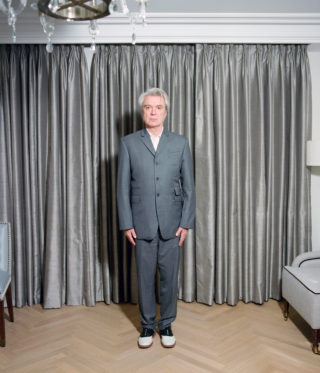
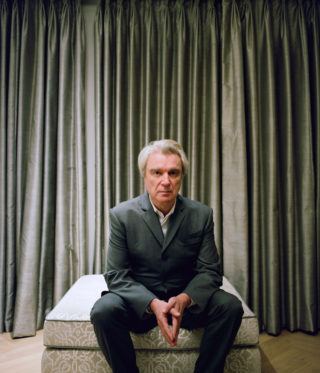
When Talking Heads broke up in 1991 it resulted in some bitter animosity. Byrne would go on to describe the group as being in “an ulcer-making world” and Tina Weymouth in particular has spoken spitefully of Byrne, once describing him as a man “who is incapable of returning friendship.” The group briefly reformed in 2002 when inducted into the Rock n Roll Hall of Fame but the discomfort was palpable. When brought to the stage they all stood sheepishly behind the microphone, waiting for someone to move forward to speak. Instead, Byrne ducked behind the whole group and hid, ensuring he’d be last to talk, if at all.
“I’m incredibly proud of everything we did,” he says when I ask him if the rabid love for his old group has ever felt like a burden. “The music we made, the shows we did, all that. But yes, sometimes, you have to try and escape from the albatross of your own reputation and move on and sometimes an audience does not want to move on. I think it’s worked out fine but there have been periods where it’s been a bit of a struggle to get an audience to move on with you but I’m also not the only artist that’s been perverse and gone out and said, ‘oh I’m not going to do any of that old stuff’. After a while you go, ‘wait a minute, they’re good songs. If you do some of those, you’ll have a better show.’” This is a philosophy that Byrne will be carrying forward with him on the ‘American Utopia’ tour, as Talking Heads classics will be played alongside new material. “There’s a lot of them that I still like. There’s some that I think remain more relevant than others, so they get carried through. It’s much easier to integrate that stuff now and it has been for a while.” As ever, a full-on Talking Heads reunion looks deeply unlikely and unwelcome.
It would also be antithetical to how Byrne has lived out his creative life to date. Whilst many considered peers of his continue to stumble forward presenting a living waxwork version of themselves as they hammer out old songs from old times with waning enthusiasm and depleted relevance, Byrne has offered multiple versions of himself across multiple art forms to create a career of David Byrne’s – a personal army of delightful oddballs.
For a period around the turn of the millennium, Byrne used to carry with him, glued to his shoulders, a big red knapsack containing a toothbrush, passport, Swiss army knife, flashlight and sewing kit. Just in case. He is an artist who is ever ready to follow the future wherever it may take him, in any moment, and he has no intention of changing this or the person behind it anytime soon. “Years ago I was having relationship problems and I went to a therapist,” he says “and…” he stops himself and rips into head-shaking laughter once more. “She was telling me that I was doing really well and that I might be done soon and I said ‘oh no, no, no. Don’t fix me completely.”